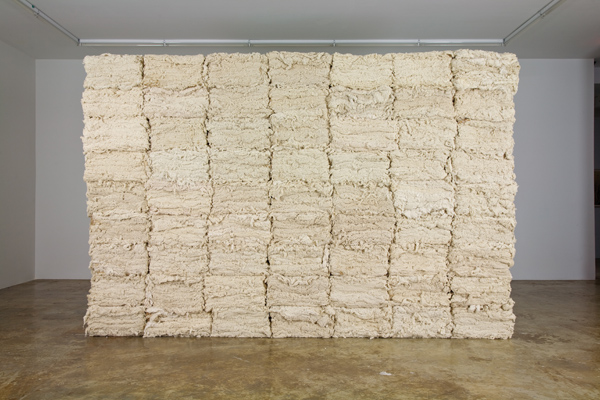30 Americans in New Orleans: Bryan C. Lee, Jr.

Leonardo Drew, Untitled #25, 1992. Cotton and wax. Courtesy the artist and the Rubell Family Collection, Miami.
Editor's Note
The next response in our series “30 Americans in New Orleans” comes from Bryan C. Lee, Jr., who talks about ownership and identity.
I wrote an article a while back for the National Organization of Minority Architects discussing the hypothetical ownership of an artistic genre by its ethno-cultural point of origin. My intentions were to define the boundaries of ownership and identity, and the representations of the powerful and powerless. In that article, blues music was the genre and African Americans were the point of origin. Blues, as a concept and language, finds its roots in the slave hymns of ancestors and was born of the trials and tribulations of those enslaved people. It then stands to reason that the language of blues would have the same rooted connection to a people and their descendants as any other formal language passed down through generations. The entire discussion revolved around the ownership, use, and assignability of an artistic language to a people as a form of identity.
Many of the same issues of ownership and identity are prevailing themes in the “30 Americans” exhibition. In this instance the questions are not so much about cultural identity as a component of people, but rather people as a component of cultural place. Where do we belong as black people? Where can we belong? Simply naming the exhibition “30 Americans,” and not “30 Black Americans,” forces important considerations of cultural identity and race in a public forum—two concepts rarely defined in relation to or distinct from one another in this country.
For me, the most daunting example of ownership and identity artwork can be found in Untitled #25 by Leonardo Drew. This piece, made of cotton bales, is detached and isolated from its geographic and historical context. In the gallery, it functions almost like an infographic, bringing to mind the man-hours needed, the dollar value attained, and the appalling conditions by which bales like these would have been created. While Drew’s identity as a black person in America may presuppose his ownership of this history, it belongs to us all. There is not a day that goes by in America, whether stemming from the actions of an ignorant NBA owner or ignorant Nevada rancher, that we are not faced with the specter of our aversion to resolving this nation's tortured past. Art is a part of this dialogue that is never more needed.
Editor's Note
Bryan C. Lee, Jr. is an architectural designer at Eskew+Dumez+Ripple. He is Vice President and Program Director of the Louisiana Chapter of the National Organization of Minority Architects. Originally from Trenton, New Jersey, he moved to New Orleans in 2011.
“30 Americans” on view through June 15 at the Contemporary Arts Center (900 Camp Street) in New Orleans.



